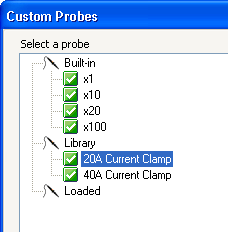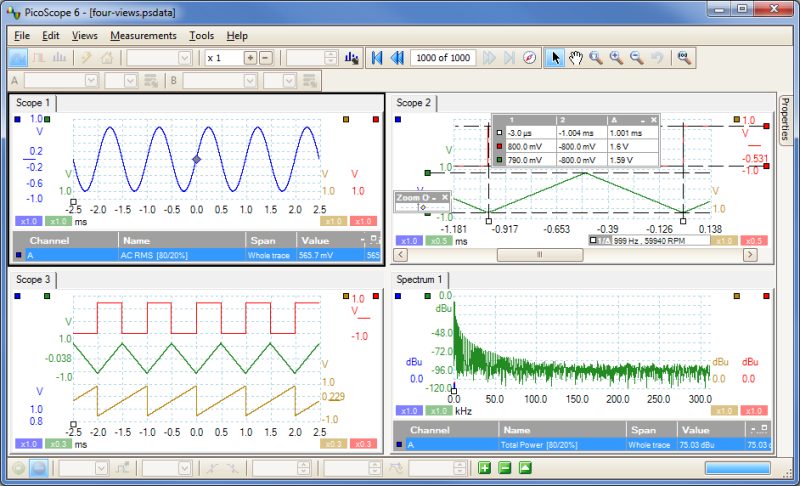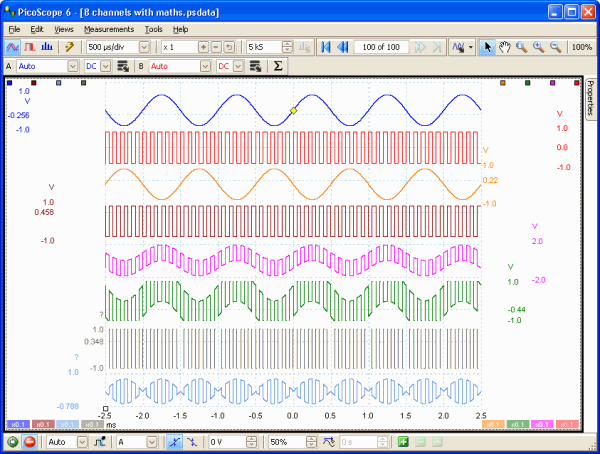High Performance 4 Channel USB Oscilloscopes
- |
- Automotive
- |
- Data Acquisition
- |
- Electrical
- |
- Environmental
- |
- Food Safety
- |
- Mechanical Measurement
- |
- Multimeters
- |
- Test & Measurement
- |
- Temperature Monitoring
- |
- Test Accessories
- |
- Thermometers
- |
high end benchtop scope, but without the cost or bulk?
Look no further
- 4 Channels and external trigger
- Bandwidths from 50 MHz to 200 MHz
- Up to 10 GS/s repetitive sampling
- Arbitrary waveform generator option
- Built in function generator/spectrum analyser
- Up to 512 MS buffer size
- Advanced digital triggers
- 1 GS/s real time sampling
- USB or mains powered
PicoScope 3400 USB Oscilloscopes all feature a high speed USB 3.0 interface, together with impressive sampling rates, high bandwidths and a very large buffer memory.
These four channel oscilloscopes simply connect to the USB port on any standard Windows based computer, making full use of your PC's processing capabilities, large screens and familiar graphical user interfaces. Whether you're used to traditional benchtop oscilloscopes or modern PC oscilloscopes all scopes in the PicoScope 3000 Series offer outstanding performance and ease of use.
What do I get?
- PicoScope 3400D Series Oscilloscope
- 4 switchable 10:1/1:1 oscilloscope probes
- Quick Start Guide
- Software and reference CD
- USB 3.0 cable
- Double-headed USB 2.0 cable
- AC power adaptor
- Free software updates
Why Pay More?
At Metermaster we don't do “optional extras”. Other companies may think that you should pay for high end features such as mask limit testing, serial decoding, advanced triggering, automatic measurements, math channels, XY mode, digital filtering and segmented memory. We don't. When you buy a PicoScope USB Oscilloscope everything is included in the price.
Great Things Come in Small Packages
Four channels, bandwidths of up to 200 MHz, real time sampling of up to 1 GS/s, up to 512 MS buffer memory, built in function generator and optional waveform generator — a PicoScope 3400 oscilloscope gives you the high performance you need in a lightweight, space saving design. Great things come in small packages.
Too Much Data to Handle?
With impressive sampling rates, high bandwidths and large buffer memory you might be wondering how can you handle all the data that your PicoScope oscilloscope provides?
Thanks to the power of PicoScope it isn't a problem: a maximum zoom factor of 100 million combined with our industry leading zoom controls means you can see every last detail of your waveform with ease. And thanks to our segmented memory the old problem of seeing a glitch on the screen only for it to vanish before you stop the scope is no more — now each captured waveform is stored in the buffer so you can rewind and review up to 10,000 previous waveforms.
If you don't want to manually check 10,000 waveforms then use the power of the software to do it for you. Select one waveform that is in specification and then use the mask limit tools to scan through the rest, highlighting any that fail.
PicoScope Oscilloscope Software
When you buy a PicoScope quad channel USB Oscilloscope you also get a comprehensive suite of software that enables you to get the most from your oscilloscope.
Start PicoScope, click Auto setup and your PC is transformed into a powerful oscilloscope with the timebase and triggering already set up.
Click Persistence mode and you can emulate the phosphor display of a conventional analogue scope, useful for displaying complex analog signals and spotting
glitches. Click Spectrum mode and your PC becomes an FFT spectrum analyser, and there's more.
PicoScope 6 Oscilloscope & Spectrum Analyzer Software
Store Up To 10,000 Waveforms In the Buffer
Ever spotted a glitch on a waveform, but by the time you've stopped the scope it has gone? With PicoScope you no longer need to worry about missing glitches or other transient events. Depending on the model of oscilloscope and the settings, PicoScope can store up to the last ten thousand waveforms in its buffer.
When you click the Start button or change a capture setting, PicoScope clears the buffer and then adds a new waveform to it every time the oscilloscope captures data. If you manage to completely fill the waveform buffer PicoScope will use the first in, first out principle to ensure that the buffer always contains the latest waveforms. Once you have stopped capturing data, you can then review each captured waveform to find the event you want. You can also save the whole buffer and examine it at a later date.
Resolution Enhancement
Resolution enhancement is a technique for increasing the effective vertical resolution of the scope at the expense of high frequency detail. Selecting resolution enhancement does not change the scope's sampling rate or the amount of data available.
Resolution enhancement adds up to four bits to the effective resolution of your oscilloscope, so a PicoScope 3400 can deliver up to 12 effective bits.
Custom Probes
The custom probes feature allows you to correct for gain, attenuation, offsets and nonlinearities in special probes, or to convert to different units of measurement (such as current, power or temperature). You can save definitions to disk for later use. Definitions for standard Pico supplied oscilloscope probes and current clamps are included.
Easy to Use
Despite the many advanced features and functions, PicoScope is still fast and easy to use. Even if you've used a traditional “knobs and buttons” oscilloscope for many years, the intuitive controls and familiar Windows user interface of PicoScope make it incredibly easy to use.

| Model | PicoScope 3403D | PicoScope 3404D | PicoScope3405D | PicoScope3406D |
|---|---|---|---|---|
| Bandwidth (-3dB) | 50MHz | 70MHz | 100MHz | 200MHz |
| Hardware Bandwidth Limit | 20 MHz, switchable | |||
| Rise Time (Calculated) | 7.0 ns | 5.0 ns | 3.5 ns | 1.75 ns |
| Channels | 4 | |||
| Vertical Resolution | 8 bits | |||
| Enhanced Vertical Resolution | 12 bits | |||
| DC Accuracy | ±3% of full scale | |||
| Input Sensitivity | 10 mV/div to 4 V/div (10 vertical divisions) | |||
| Input Characteristics | 1 MΩ ±1% in parallel with 13 pF ±1 pF | |||
| Input Type | Single-ended, BNC connector | |||
| Input Coupling | Software selectable AC/DC | |||
| Input Ranges (Full Scale) | ±50 mV to ±20 V in 9 ranges | |||
| Analogue Offset Range 50 mV to 200 mV ranges 500 mV to 2 V ranges 5 V to 20 V ranges |
±250 mV ±2.5 V ±20 V |
|||
| Overload Protection | ±100V (DC+AC peak) | |||
| Maximum Sampling Rate (Single Shot) One Channel in Use Two Channels in Use 3 or 4 Channels in Use |
1 GS/s 500 MS/s 250 MS/s |
|||
| Maximum Sampling (ETS)Rate (Repetitive Signals) | 2.5GS/s | 2.5GS/s | 5GS/s | 10GS/s |
| Maximum Sampling Rate (Continuous Streaming Mode) | ≥ 10 MS/s (PC dependent) | |||
| Buffer Memory | 64 MS | 128 MS | 256 MS | 512 MS |
| Waveform Buffer | Up to 10 000 waveforms | |||
| Timebase Ranges | 1 ns/div to 200 s/div | 500 ps/div to 5000 s/div | ||
| Timebase Accuracy | ±50ppm | |||
| Sample jitter | < 5 ps RMS | |||
| Accessories Included | |||
|---|---|---|---|
| Additional Hardware | 4 x oscilloscope probes, Single–headed USB cable, Double–headed USB cable, Universal mains (AC) power supply | ||
| Software | software CD-ROM | ||
| Documentation | User manuals | ||


